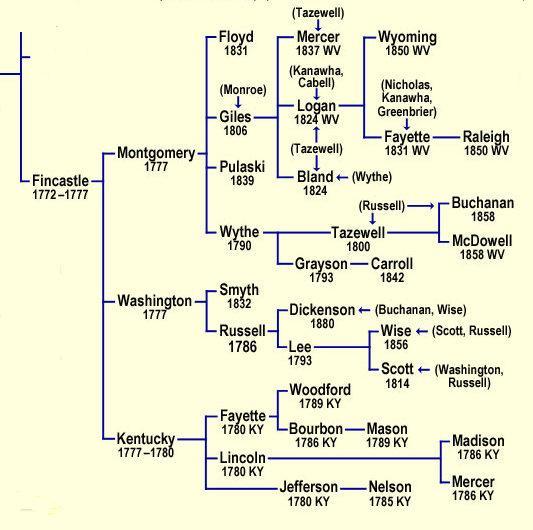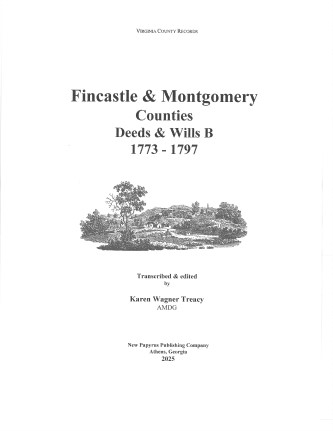






 
Home
Reference
Census Records
Military
African-American
Other States
New Titles
E-BOOKS
FREE SHIPPING IN USA
Iberian Publishing Company's On-Line Catalog:
Fincastle County Virginia
 With the 1770s came the expansion of the frontier and the legal demands of property. This brought the formation of Botetourt County, named for Lord Botetourt, governor of Virginia, as an answer to those in the Southwest petitioning for a closer court. Botetourt County comprised all of the territory originally in the county of Augusta west of the Blue Ridge Mountains with the possible exception of that included in the far west along the Mississippi. With the 1770s came the expansion of the frontier and the legal demands of property. This brought the formation of Botetourt County, named for Lord Botetourt, governor of Virginia, as an answer to those in the Southwest petitioning for a closer court. Botetourt County comprised all of the territory originally in the county of Augusta west of the Blue Ridge Mountains with the possible exception of that included in the far west along the Mississippi.
The full text of the Act forming Botetourt is as follows:
"An Act for dividing the County and Parish of Augusta, and for adding certain islands in the Fluvanna River, to the counties of Albemarle and Amherst. Whereas, many inconveniences attend the inhabitants of the county and parish of Augusta, by reason of the great extent thereof, and the said inhabitants have petitioned this General Assembly that the said county and parish may be divided: Be it therefore enacted, by the Governor, Council, and Burgesses, of this present General Assembly, and it is hereby enacted, by the authority of the same, That from and after the thirty-first day of January [1770] next ensuing, the said county and parish of Augusta be divided into two counties and parishes, by a line beginning at the Blue Ridge, running north fifty-five degrees west, to the confluence of Mary's Creek, or the South River, with the north branch of James River, thence up the same to the mouth of Carr's Creek, thence up the said creek to the mountain, thence north fifty-five degrees west? as far as the courts of the two counties shall extend it; and that all that part of the said county and parish which lies on the south side of the said line shall be one distinct county and parish, and called and known by the name of Botetourt; and that all the other part thereof, which is on the north side of the said line, shall be one other distinct county and parish, and retain the name of Augusta."
An additional clause in the enabling act covered the few settlements along the Mississippi Basin are: "And, whereas the people situated on the Mississippi, in the said county of Botetourt, will be very remote from the courthouse, and must necessarily become a separate county as soon as their numbers are sufficient, which will probably happen in a short time; Be it therefore enacted by the authority aforesaid, that the inhabitants of that part of said county of Botetourt which lies on the said waters shall be exempted from the payment of any levies to be laid by the said County Court for the purpose of building a courthouse and prison for said county."
This area, though intended to give legal relief to the western area, proved too enormous and the county of Fincastle was born in 1773, to take effect the following year at the first court of 5 January 1773: [The new county’s name was derived from “Fine Castle”, the English country estate of Lord Botetourt.]
"An Act for dividing the County of Botetourt into two distinct counties. Whereas, it is represented to this present General Assembly, by the inhabitants and settlers on the waters of Holston and New rivers, in the county of Botetourt, that they labor under great inconveniences, by reason of the extent of the said county, and their remote situation from the courthouse: Be it therefore enacted, by the Governor, Council, and Burgesses of this present General Assembly, and it is hereby enacted, by the authority of the same, That from and after the first day of December next the said county of Botetourt shall be divided into two distinct counties, that is to say, all that part of the said county within a line to run up the east side of New River to the mouth of Culberson's Creek, thence a direct line to the Catawba road, where it crosses the dividing ridge, between the north fork of Roanoke and the waters of New River, thence with the top of the ridge to the bent where it turns eastwardly, thence a south course, crossing Little River, to the top of the Blue Ridge Mountains, shall be established as one distinct county, and called and known by the name of Fincastle; and all that other part thereof, which lies to the east and northeast of the said line, shall be one other distinct county, and retain the name of Botetourt."
Fincastle County lost its identity after less than four years of existence and fewer than three dozen court sessions, and in 1776, by an Act of the General Assembly, the counties of Montgomery, Washington, and Kentucky were formed from its original territory. In all, an entire state [Kentucky] and two dozen Virginia/West Virginia counties count Fincastle as their parent county [see attached chart]. The name "Fincastle" was retained by Botetourt in her county seat.
From the chart it is evident that this county was destined soon to be further subdivided.
For a better understanding of county boundary changes, see our new section Virginia in Maps
Iberian also has hundreds of titles in e book (PDF) format!! Click here for a complete online catalog of available titles
 FINCASTLE CO., VA COURT RECORDS, ORDER BOOKS 1 AND 2, 5 January 1773 to 3 September 1776 containing a verbatim transcription of records for every court held in Fincastle, transcribed by Karen Wagner Treacy. 10 1/2 x 8 1/2, x, 257 pages, illustrrations, full name index. FINCASTLE CO., VA COURT RECORDS, ORDER BOOKS 1 AND 2, 5 January 1773 to 3 September 1776 containing a verbatim transcription of records for every court held in Fincastle, transcribed by Karen Wagner Treacy. 10 1/2 x 8 1/2, x, 257 pages, illustrrations, full name index.
From the Introduction:
Fincastle County Virginia was in existence only between 1773 and 1776, a mere three years, yet those three years were some of the most formative of the Virginia frontier. Once the treaty of Fort Stanwix was signed in 1768, enabling settlers to return to their homesteads, the economic tableland
of Virginia began tipping toward the Southwest. The first official response was the 1770 formation of Botetourt County, to separate from the unmanageably large Augusta County an administrative area that could respond to the needs of the Western Waters. Between its own oversized territory
and the increasing population, and the need for protection from Indian raids, Botetourt spun off Fincastle County in 1773, to govern the area during the crucial years of Dunmore’s War and the beginnings of the Revolution. One of the earliest expressions of the growing need for American independence
was the Fincastle Resolutions of 1775, addressed to the Virginia Continental Congress. All thirteen signers appear in these pages as prominent men of Fincastle County.
William Campbell; Arthur Campbell; William Christian; Walter Crockett; Charles Cummings; William Edmondson; William Ingles; Thomas Madison; James McGavock; John Montgomery; William Preston; Evan Shelby; and Stephen Trigg,
Two extremely valuable reference works which should be consulted for any study of Virginia frontiersmen in this period are among the many useful publications by Mary Kegley: New River Tithables, 1770-1773 (1972) and Soldiers of Fincastle County, 1774 (1974).
Reuben Gold Thwaites and Louise Phelps Kellogg, eds. Documentary History of Dunmore's War, 1774. Madison: Wisconsin Historical Society, 1905, is indispensable for the context of the abbreviated county courts in the frenzied activity of Dunmore’s War.
In 1776 The Virginia Convention revisited the Fincastle County government. All county officers swore new oaths to the Commonwealth of Virginia. Yet the reach of the county court was still inadequate to the geographical range of its boundaries, and once again the county was split. This time Fincastle County disappeared from the books, replaced by Washington, Montgomery, and Kentucky Counties. Kentucky County would eventually become an entire state. Washington and Montgomery Counties survive, although as the remnants left as more new counties were created. The town of Fincastle is now the county seat of Botetourt County. The original proposed county seat for Fincastle, near the Lead Mines, is now in Wythe County.
Three years of court minutes filled 300 pages in two ledgers. In book 1, the first 149 pages comprise the Fincastle minutes through November 1773, at which point the book was apparently lost for a time. It resumes on page 150 with the Montgomery County court for 25 January 1785. Fincastle minutes begin again in a second volume, covering pages 1-151, ending with 3 September 1776 and then continuing directly on to Montgomery County Court of 7 January 1777. The time court sat in session shortened and the time between courts grew with the frontier and political unrest. Several chronological discrepancies exist, with entire court sessions entered out of order.
The bulk of the material is lawsuits for debt. Was the drive to have a court close at hand really for the benefit of the shop keepers, in order to more effectually collect their accounts? Civil cases predominated. A County Sheriff had more economic functions than law enforcement duties. The odd case of theft or trover, slander, rumor-mongering, several cases of trespass, assault and battery (abbreviated TAB), and one accusation of attempted murder: these are the criminal proceedings. Government was more concerned with other matters of public interest: certifying hemp crops, surveying and recording deeds, the orderly administration of estates, opening and maintaining roads, licensing ferries and ordinaries, managing tithables and taxation, and supporting the local militia.
Two books have been published containing the Fincastle Court minutes. Lewis P Summers in 1929 published Annals of Southwest Virginia. This contained about 25% the court minutes, enough to give a feel for the material, but concentrating on the court orders and virtually ignoring the lawsuits, where names of so many of the less prominent residents occur. In 1987 Michael and Bettie Cook published a useful collection of records Fincastle & Kentucky County, VA - KY, Records and History, which includes legislative acts, deeds and land grants, albeit for the most part in excerpts. Unfortunately, it is now out of print. Without criticizing these efforts, I feel that a verbatim transcription of the records would be of much use in placing the settlers in a more complete context.
I have exercised great care in transcribing the original (from microfilm) as exactly as I could. In several places my reading differs from Summers and Cook, but interested researchers can consult the originals and judge for themselves. The manuscript is hard enough to read to justify almost any interpretation! There are at least three hands, two are rather similar but distinguishable by their habits of spelling. One spelled Sheriff consistently with two f’s, the other didn’t. The ff man wrote ‘Mountgomery ‘ instead of Montgomery. The third hand is a quite different, less slanted, spelling ‘deputy’ as ‘debuty’ and ‘Deverax’ as ‘Deborax’ throughout, and writing lower case d’s. With the exception of capitalizing personal and place names, I made no attempt to correct spelling, capitalization, to eliminate doubled words, or to otherwise edit the material. I did insert commas between series of names and a few periods here and there, but apostrophes (or lack of them) are as they appeared.
I wish space permitted me to comment on the human interest that makes this sort of work so fascinating, but I will restrain myself to one story: Drury Puckett having failed to pay his accounts, the sheriff went to confiscate his personal property to sell to cover the debt. “The Sheriff, having made return on the attachment Granted the plaintifs in this Cause Executed on a small Catt and the Defendant being again Solomenly Called & failing to appear the plaintif produced his Note of Twenty Eight pounds Seven Shillings & Six pence. Therefore It is Considered by the Court that the plaintifs recover against the said Defendant the said sum of Twenty eight pounds Seven shillings and six pence Together with their Costs by them about their Suit in this behalf Expended & the said Defendant in mercy &c. And the Catt attached as above is ordered to be released.“ .
To view a digital copy (pdf) of the index to this book, visit Index-Fico
(Close the pdf file with the left arrow to return to Iberian's catalog)
[FICO] $37.00
 FINCASTLE AND MONTGOMERY COUNTIES DEEDS & WILLS B, 1773-1797 transcribed & edited by Karen Wagner Treacy. 10 1/2 x 8 1/2, vi, 232 pages, index. FINCASTLE AND MONTGOMERY COUNTIES DEEDS & WILLS B, 1773-1797 transcribed & edited by Karen Wagner Treacy. 10 1/2 x 8 1/2, vi, 232 pages, index.
From the author's Intruduction:
Deeds and Wills B, 1773 - 1797 contains a variety of records from Fincastle and Montgomery county. This transcription was made from a book of reversed photocopy images, barcode 27828 at the Library of Virginia, and also microfilm reel 1 in their Montgomery county records, catalogued as Deeds and Wills B, 1773 - 1797 (Fincastle and Montgomery Counties) Unpaged index, p. 1-282 (Montgomery County Deeds, 1789-1796); p. 1-31 (Fincastle County Deeds & Wills, 1773-1776, follows p. 282); p. 32-240 (Montgomery County Wills, 1777-1797). The record in in two parts, and the second set of page numbers begins again with pp1. It is not immediately consecutive: p.240 has a torn corner which is not matched on pp.1. (To distinguish between the two parts, I have referred to the first part as beginning with 'p1' and the second part with 'pp1'.)
Fincastle County was formed in 1772 from part of Botetourt County, which in turn was formed in 1770 from Augusta County. Fincastle was only in existence for three years and its territory was then was parceled out to Montgomery, Washington, and Kentucky counties. The records from the Fincastle era were predominately wills, inventories, and performance bonds for executors and administrators.
Deeds and Wills A was previously published in abstract by James Douthat as Montgomery County, VA deed book A, 1773-1789, Mountain Press, 1987. Volume B was used by Mary Kegley in her dissertation Pioneer Possessions, A Study of Wills and Appraisals of Southwest Virginia 1745-1786, for her Master of Arts degree from Radford University, 1975.
The first part of this present volume contained primarily wills and related matters, as well as performance bonds for public officials. The second part consisted solely of deeds. The wills and inventories are given verbatim, but some of the other material was edited to remove repetitive material. Descriptions of the property bounds for the deeds were much curtailed, but all names were retained.
To view a digital copy (pdf) of the index to this book, visit Index-Fnmt
(Close the pdf file with the left arrow to return to Iberian's catalog)
[FNMT] $35.95
For more records pertaining to FINCASTLE COUNTY, VIRGINIA see also:
    
Please see our HELP PAGE for mail-order instructions, wholesaler policies and other contact information.
|| Virginia/W.Va. || General Reference || Military Records ||
|| Other States || E-Books || New Titles || Home Page || E-Books ||
Copyright 2025 Iberian Publishing Company
|